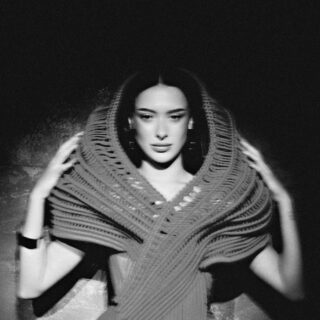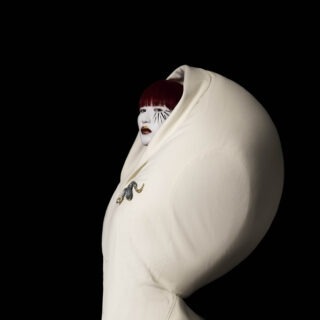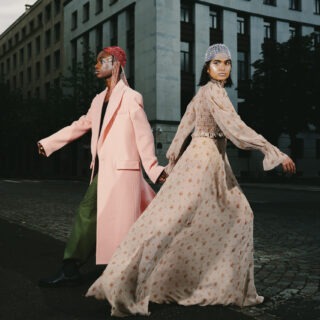words. Alexey Nilov
photos. courtesy of DRESSX
issue 1 – in love with Switzerland
How would you justify the existence of the Metaverse and the relevance of digital fashion? Is it more entertainment or potential for the development of the fashion industry?
Natalia Modenova: The transformation of traditional fashion into its Metaverse counterpart, which we call ‘metafashion’, happened and continues to happen very naturally, supporting the overall change in how we live and explore the world around us. Digital assets were in place in gaming for a while, but the game is changing, and we already became “the avatars of ourselves” in the multiple social media channels, messaging, and streaming services. Digital fashion is designed to dress our digital selves. People from tech and gaming backgrounds get it fast and a mass audience is starting to actively follow – this is a common pattern when innovative products are launched. Wearables are the most natural extension of the metaverse and the most important pillar of the metaverse economy.
Daria Shapovalova: We see this rise of digital fashion as a very natural process in the traditional industry. The growth of people’s online presence and ‘digital lives’ through social media and video calls created a demand for digitally native features, which naturally would also mean digital clothing. The pandemic has accelerated the growth of the digital fashion industry by highlighting both issues – issue of sustainability in fashion, overproduction, and overconsumption, as well as increased online presence forced by the spread of the virus and the regular lockdowns. Digital fashion was born as a solution for several main problems of the industry, with sustainability being at the very core of the concept.
What idea and philosophy did you put into the platform when you created it in 2020? Were expectations justified?
Daria Shapovalova: After 15 years in the traditional fashion industry, we realized that we want to contribute to its significant shift to a more sustainable, affordable, and digital future.It is not a secret anymore that the fashion industry is considered one of the largest polluters in the world. The production and distribution of the fibers and garments used in fashion all contribute to different forms of environmental pollution, including water, air, and soil pollution, while overproduction and overconsumption of the fashion items are among the main factors creating the pollution. Barclays Bank research has shown that 9% of customers in some developed countries only buy new clothes to take a picture for their social media only to return them later, and while we genuinely share the beauty and excitement that physical fashion creates, we believe that there are ways to produce less, produce more ethically, or not produce at all.
Natalia Modenova: Being previously in media and fashion businesses, we understood that the future of fashion (same as of all the other fields) is in the intersection with technology and that was a big driver to start DRESSX. Two years ago, we started by introducing the use case of digitally dressing clients’ photos in 3D fashion, while now DRESSX already offers instant AR try-on on photos and videos with an opportunity to instantly share the results from the DRESSX app to major social media platforms. DRESSX metafashion can also be worn on avatar in the virtual-only environment, for instance in Meta Avatar Store, Roblox, our flagship store in Decentraland or virtual reality showroom created with Accenture and Microsoft on AltspaceVR platform, soon in ZEPETO with DRESSX brand shop and more of the virtual worlds. In March this year, we launched our own NFT Marketplace, adding utility to fashion NFTs and enabling the owners to wear their fashion artworks on photos and videos via the DRESSX app.
hion fun and enjoying the thrill of buying new clothes and creating amazing fashion content.
Who designs digital clothing for Dress X? Who plays the role of creative director? What are your roles in the company?
Natalia Modenova: With DRESSX, we aim to give equal opportunities for the creators all around the globe to showcase their designs and make their creative voices heard in the industry. While we have our own vision for digital fashion with more complicated and bold 3D assets exceeding the boundaries of the physical reality, we are trying to keep a fair balance featuring different styles and aesthetics, celebrating creativity, and building a diverse community of the fashion creators of the future.
Daria Shapovalova: DRESSX works with fashion creators worldwide, selecting the most promising talents, curating the collections, and helping young and established 3D and traditional fashion designers to make additional revenue streams through the digital world. DRESSX also owns its namesake digital fashion brand, launching the collections curated and created by our team regularly, dedicating them to the important milestones in the history of fashion and art, industry events, seasonal topics and more.
Daria Shapovalova is a DRESSX co-founder and CEO, Natalia Modenova is a DRESSX co-founder and COO, while the third founding member Julie Krasniienko is a DRESSX Head of Production, involved directly in the collection’s development.
If we look into the future, over the next 3-5 years, will digital fashion become more applied? Will it be able to replace physical clothing, for example, in videos, and not just in overlay format on photos? Is it possible for alternative Fashion Weeks to appear in the Metaverse?
Daria Shapovalova: We build DRESSX as a metacloset – an ultimate destination for both consumers, digital and traditional fashion brands to enter the Metaverse. DRESSX not only sells virtual clothing, but also offers the whole spectrum of services, starting from digitizing physical collections or creating digital clothes from scratch, to adding another layer (utility) to fashion NFTs, allowing collectors to wear those in augmented reality through the DRESSX app, in Roblox, Decentraland or other virtual realities. There are already numerous Digital Fashion Weeks emerging in the Metaverse to address the new trends and ways of self-expression and we expect only more of them to appear in the next couple of years, reflecting the overall growth and development of the digital fashion industry.
Natalia Modenova: Our big aim is to provide an endless digital closet to every person in the world for their digital presence with no boundaries to express themselves creatively. Same with the creators – 3D and fashion designers, we want to empower talents and provide them with a safe place to create and grow professionally. Meta fashion creates a great opportunity for the industry to get to the next level and open new opportunities, create new markets and integrate in a digital creative economy.
You have created a fairly large number of collaborations with major brands. What does this partnership bring to you as a platform and what does it bring to brands?
Daria Shapovalova: Indeed, since DRESSX launch in August 2020, we have partnered with numerous leading tech, fashion, and lifestyle companies, including Meta, Roblox, Snapchat, Google, Coca-Cola, FARFETCH, Adidas, DUNDAS, American Eagle and more.
Natalia Modenova: For the brands partnering with DRESSX means entering the digital fashion space with one of the leading companies in the field, using our experience and know-how for digital fashion and AR assets creation. Following the fast development and growth of the industry in recent years, brands realize that the only way to navigate the digital change is to be one of the first to lead it. DRESSX offers traditional fashion brands the full support in their Metaverse journey, from creation and production of the 3D collection to distribution and marketing. For DRESSX, having traditional brands on board means extending our reach, elevating the DRESSX Metacloset (™) experience and getting closer to our main goal of providing the extensive virtual wardrobe experience to every person in the world.
How do physical and digital fashion interact today? And what is the potential for diversification in this area?
Natalia Modenova: We believe that in the future every fashion brand – luxury, haute couture, streetwear, everyone – will own a digital fashion line. Same as high-fashion luxury brands have perfumes or accessories. With a difference from the physical item price point yet high precision, digital fashion will become a new way for customers to enter the high fashion world, discovering the new way to shop luxury, reducing their environmental footprint, and experiencing the same excitement from wearing and owning designer pieces in digital.
Daria Shapovalova: We are very lucky to have more and more interest from the traditional fashion industry with popular brands reaching out to us aiming to expand and grow through the digital fashion realm. DRESSX has launched a digital fashion partnership with FARFETCH, creating digital influencer campaigns for Burberry, Dolce & Gabbana, Palm Angels, Balenciaga, Nanushka and more, partnered with Coca-Cola to support the launch of the company’s new flavour, launched out-of-this-world digital jeans with American Eagle, created a 3D fashion campaign with Bershka, dressed Maye Musk for the cover of Vogue Czechoslovakia, and digitized Balenciaga and Miss Sohee couture dresses from the cover of Vogue Singapore, allowing everyone to wear the dresses in AR for free and feel like a real cover star. We receive a lot of positive feedback when it comes to bringing big traditional fashion brands into the virtual space. Naturally, people are excited to be able to try on the clothes that they wouldn’t dare to purchase or couldn’t afford to buy in the physical space.
© Schön! Switzerland. All rights reserved.






